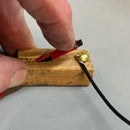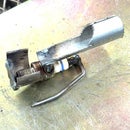Introduction: Make a NordicTrack Portable
This is a basic NordicTrack Ski Machine. It is the Challenger model. It is almost 20 years old. We bought it at a store for used sports equipment. When we have overnight guests we need to move it from this room to another. It is very awkward to pick up and carry. It would be very handy to have wheels under it. (Some of the more expensive models did come with rollers under one end, but not the Challenger, which is similar to the 303 and the 505.)
Step 1: Free Steel
Our neighbor discarded the grass catcher from her lawnmower because the fabric bag had holes worn in it. I asked her if I could have the steel frame for it. The portion at the left of the photo is solid rod. The portion toward the right half of the photo is hollow tubing just a bit more than 1/2 inch in diameter. That is almost perfect for mounting two nylon lawnmower wheels.
Step 2: Straighten the Tubing
I cut the tubing from the solid steel rod. My planned wheeled support for the NordicTrack will require an axle longer than any of the straight sections on the old grass catcher. I could cut straight sections out and weld them together. The better option seemed to be simply to straighten one of the bends. I put the tubing into my vise and gently made small bends. I did the best I could as I repositioned the tubing in my vise after each small bend. I checked my progress against this wooden straightedge. When I was done, the results were not perfect, but the tubing followed the straightedge when checked in various positions. That is all I need.
I do not want to cut the tubing to length, yet.
I do not want to cut the tubing to length, yet.
Step 3: Fit the Axle Holes
I would have liked to find free wheels, but bought two of these 6 inch plastic lawnmower wheels. They have 1/2 inch axle holes. I was able to enlarge the axle holes sufficiently by twisting and pushing the wheels onto the end of the tubing. If necessary, a rat tail file can be used to touch up the axle holes.
Step 4: Make Brackets
I used two pieces of 1/8 x 1/2 inch strap iron to make brackets that will hook over the tubular axle. One piece is 2 inches long. The other is 1 inch long. I rounded the corner where it hooks over the axle. See the yellow boxes in the graphic. Two of these brackets are needed.
Step 5: Position the Axle and Mark
I removed the rubber cups on the bottom of the NordicTrack and used spring clamps to position the axle on the NordicTrack's frame. This axle is not designed to be strong enough to leave it on the NordicTrack during use, but only to be slipped into place when it is time to move the Ski Machine from one room to another. If I had used solid rod for the axle, I could have considered welding it directly to the frame of the NordicTrack. But, the Ski Machine would tend to creep a little on the floor. I prefer to have the NordicTrack rest on four solid feet rather than two feet and two wheels.
Step 6: Bare Metal Needed for Welding
The NordicTrack has a very nice coat of paint on some heavy gauge tubing. In order to weld the brackets from step 4 to the frame of the NordicTrack, some paint will need to be removed. I marked the area needed with masking tape and ground the paint away.
Step 7: Weld
I welded the brackets from step 4 to the frame of the NordicTrack where I removed paint in step 6. Weld on both sides of each bracket.
Step 8: Bracket Modification
I added a tab to the outer side of each bracket from step 4. Each is bent to follow the contour of the rounded nose on the brackets and it is also rounded to center the NordicTrack on the axle set.
Step 9: Tack Weld Washers
I tack welded a washer to the axle at the inner surface of each wheel. This will guide the axle set when slipped into place and center it against the bracket tabs added in step 8. I added a piece of square tubing on one side to keep the axle from spinning and insure that the wheels turn rather than the axle.
Step 10: Attach Wheels
I cut the tubular axle to length and drilled a hole in each end for cotter keys. Allow space for a washer on the outside, too.
Step 11: Sliding the Wheels Into Place and Using
The photo shows the axle set in place for use. The yellow message boxes help identify the various parts in relation to one another for the viewer's orientation. To place the axle set in place, raise the front of the NordicTrack. Push the axle set up to the NordicTrack frame with one foot. Lower the NordicTrack onto the axle. The brackets will push the square tubing down and into place. Watch that the square tubing does not go into the bracket pointed upward. That is not likely, but might be possible.
Step 12: Storage
When the wheels are not in use the axle can simply rest on top of the brackets.
Spray paint the brackets and any marred areas with gloss black acrylic spray paint. Mask anything that should not be painted.
To use, attach the NordicTrack to the axle set as described in step 11. Grab the upper part of the NordicTrack with one hand and pull downward so the back end of the Ski Machine rises and wheel it to its new location. This works very well when moving to another room on the same level. It does not work so well on steps, but could if the axle set were locked to the NordicTrack rather than just resting on the axle set.
When the back end of the NordicTrack rises, the wooden skis will slide forward off of the front of the machine. It is possible to remove them before moving the machine. It would be possible to run a short bungee cord from the axle up and over the top of the "U"-shaped frame piece and back to hook again on the axle. One would be needed for each side and could be directly in front of each ski. That would hold the axle set more firmly to the NordicTrack so stairs could likely be negotiated.
Or, try this. I bought a spring for a screen door and cut two pieces from it about 3 3/4 inches long. I bent the cut ends to make loops for attaching hooks. I made two hooks for the tubular axle and two larger hooks for the NordicTrack frame. I place the springs so they are in front of the ski ends. These work very well to keep the axle and the skis in place while moving the NordicTrack. Also, I found I can collapse the entire NordicTrack and then pick it up from the rear end. That gives it a much shorter turning radius for going around corners, etc. I may even be able to store it upright in a closet.
Note: I posted a topic in the forums on rebuilding the clutch drive rollers when they begin to slip. Click on this link. I have also posted an Instructable on several other adaptations I made to our NordicTrack ski machine, including how to store it vertically in a closet.
Spray paint the brackets and any marred areas with gloss black acrylic spray paint. Mask anything that should not be painted.
To use, attach the NordicTrack to the axle set as described in step 11. Grab the upper part of the NordicTrack with one hand and pull downward so the back end of the Ski Machine rises and wheel it to its new location. This works very well when moving to another room on the same level. It does not work so well on steps, but could if the axle set were locked to the NordicTrack rather than just resting on the axle set.
When the back end of the NordicTrack rises, the wooden skis will slide forward off of the front of the machine. It is possible to remove them before moving the machine. It would be possible to run a short bungee cord from the axle up and over the top of the "U"-shaped frame piece and back to hook again on the axle. One would be needed for each side and could be directly in front of each ski. That would hold the axle set more firmly to the NordicTrack so stairs could likely be negotiated.
Or, try this. I bought a spring for a screen door and cut two pieces from it about 3 3/4 inches long. I bent the cut ends to make loops for attaching hooks. I made two hooks for the tubular axle and two larger hooks for the NordicTrack frame. I place the springs so they are in front of the ski ends. These work very well to keep the axle and the skis in place while moving the NordicTrack. Also, I found I can collapse the entire NordicTrack and then pick it up from the rear end. That gives it a much shorter turning radius for going around corners, etc. I may even be able to store it upright in a closet.
Note: I posted a topic in the forums on rebuilding the clutch drive rollers when they begin to slip. Click on this link. I have also posted an Instructable on several other adaptations I made to our NordicTrack ski machine, including how to store it vertically in a closet.





